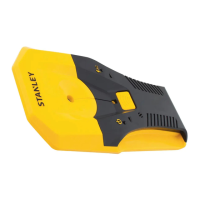5
E
Contents
• Stud Sensor Information
• User Safety
• Battery Safety
• Installing AAA Batteries
• Using the Stud Sensor
• Maintenance
• Troubleshooting
• Service and Repairs
• Warranty
• Specications
Stud Sensor Information
The Stud Sensor STHT77587/STHT77588 uses electronic
signals to locate the center of wood or metal studs, or live AC
wires through drywall or other common building materials.
PLEASE NOTE:
• The stud sensor will not detect objects in concrete, mortar,
block, brick work, plaster, carpeting, foil- faced materials,
metallic surfaces, or ceramic tile.
• The stud sensor is not designed to locate non-ferrous or
plastic objects, such as pipes.
Once the center of a wood or metal stud has been detected
in one pass across the surface, the Stud Sensor STHT77587/
STHT77588 turns on an LED and sounds an audible tone.
A marking hole allows you to easily note the stud center
User Safety
Safety Guidelines
The denitions below describe the level of severity for each
signal word. Please read the manual and pay attention to these
symbols.
WARNING: Indicates a potentially hazardous
situation which, if not avoided, could result in serious
injury.
CAUTION: Indicates a potentially hazardous situation
which, if not avoided, may result in minor or moderate
injury.
NOTICE: Indicates a practice not related to personal injury
which, if not avoided, may result in property damage.
If you have any questions or comments about this or any
STANLEY
®
tool, go to http://www.STANLEYTOOLS.com.
WARNING:
Read and understand all instructions. Failure to
follow the warnings and instructions in this manual
may result in serious personal injury.
SAVE THESE INSTRUCTIONS
WARNING:
The following label information can be found on your
tool for your safety.
AAA
Made in China
AAA
Made in China
CAUTION:
Protect your eyes. Wear safety goggles.
WARNING:
This tool is not a measuring device and should
not be used as a substitute for a voltmeter.
WARNING:
The LED or Live Wire Detection symbol on the
display is just an indicator and in some situations
the voltage detection option may not accurately
indicate the presence of voltage in a wall in the
event of internal device failure or improper operation,
and therefore should not be solely relied upon for
identication of the presence of hazardous voltages.
Other evidence, such as construction blueprints or
visual identication of wiring or conduit entry points
should also be utilized.
Always follow proper safety practices and use
a separate detection method to verify a de-energized
condition prior to commencing work.

